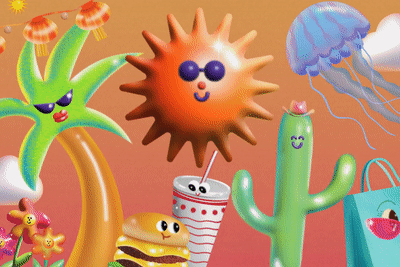Move over happy hour, there’s a new corporate response to stressed-out workers
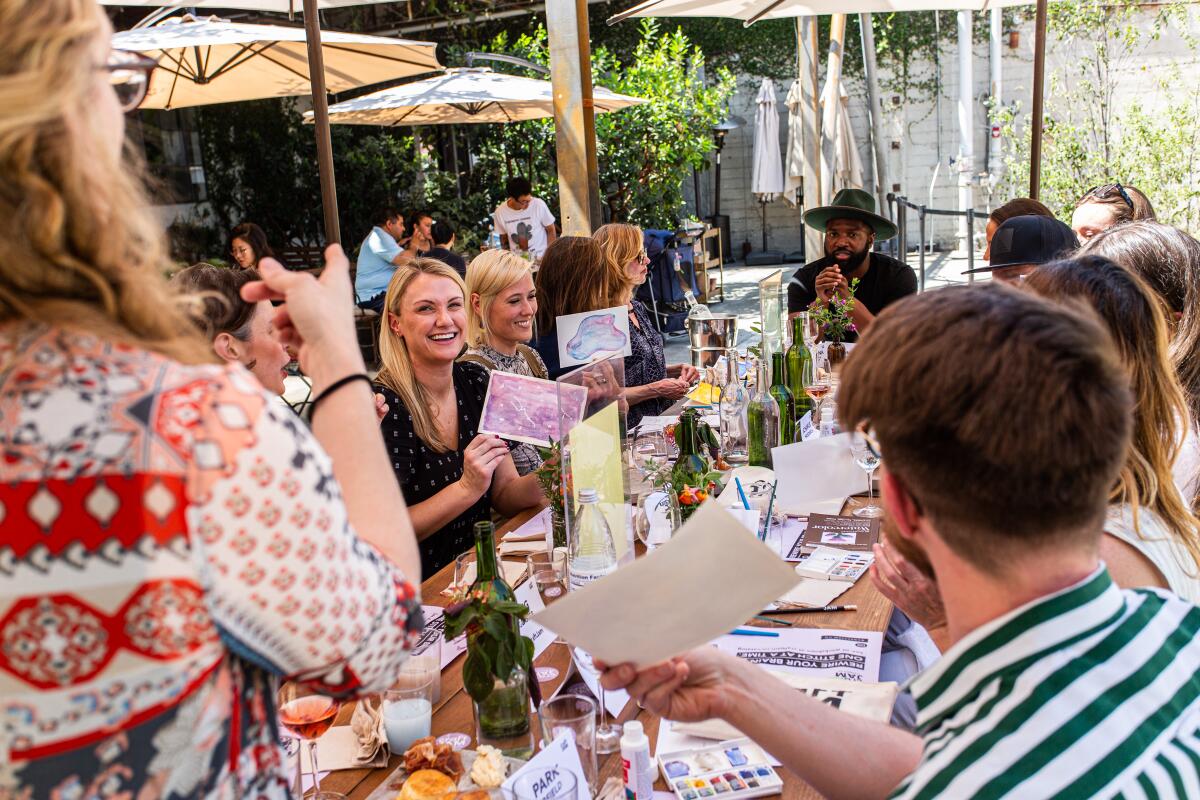
- Share via
Painting sunsets and tie-dying T-shirts might be more closely associated with middle school than corporate America, but such artistic activities are making their way into workplace wellness.
Twitch employees braided friendship bracelets. Tinder staff wood-burned cheese boards. And over 100 Zynga employees participated in a glass-etching class.
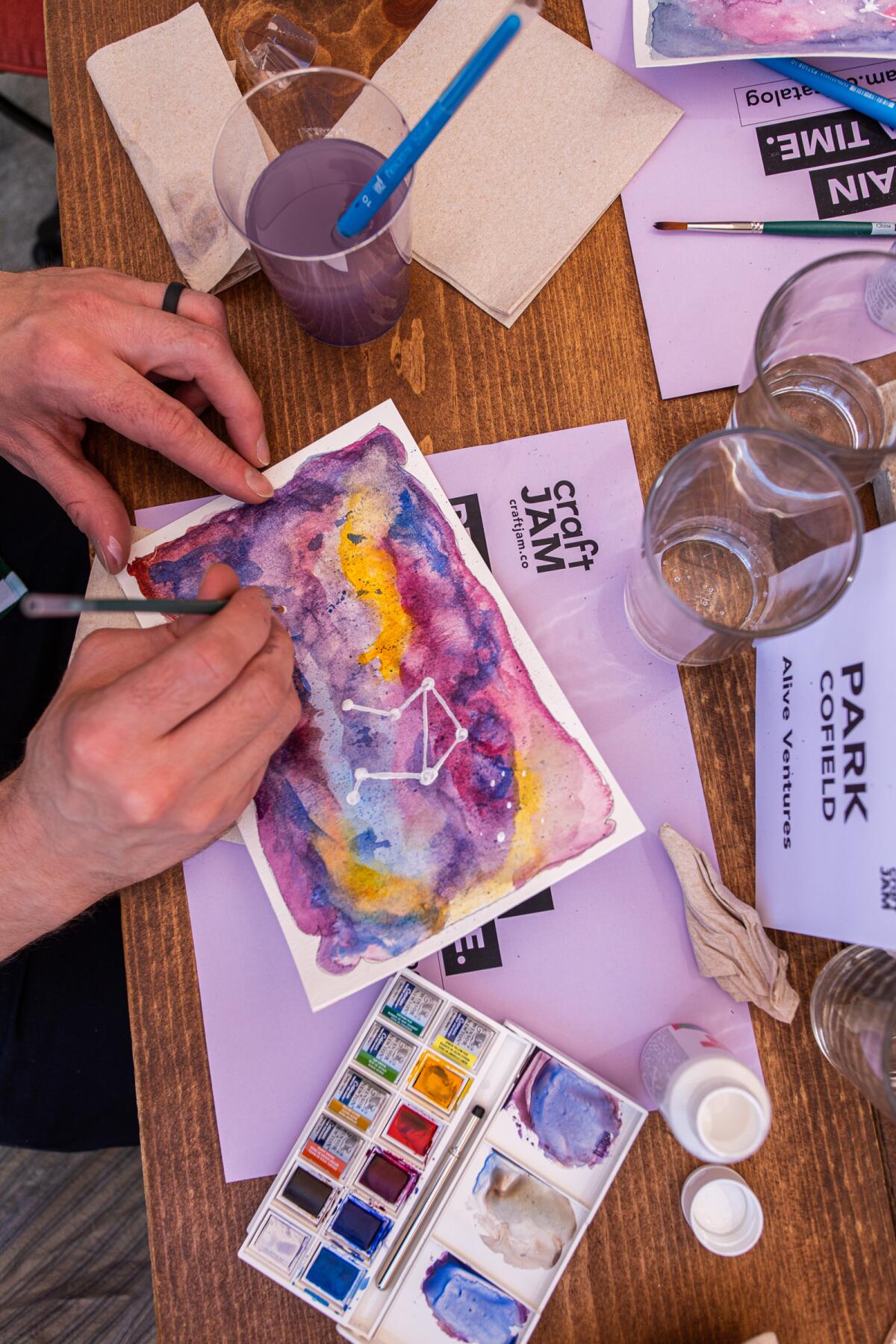
The crafting workshop company CraftJam hosted a watercolor painting session for current and potential clients — namely human resource managers — in April in the outdoor courtyard of the Arts District restaurant Manuela. Attendees swirled brushes into watercolor palettes to paint their zodiac sign as the instructor explained how to layer colors. While working on their masterpieces, participants discussed how employees look to the arts for therapeutic relief, a trend that took off in 2020.
During the pandemic, Americans rediscovered tactile hobbies and crafting. Some knitted. Others took up quilting. Many baked sourdough bread. Now companies, looking to prevent burnout, have followed suit.
The arts provide employees with a healthy form of therapeutic relief, says Nora Abousteit, the founder and chief executive of Los Angeles-based crafting workshop company CraftJam, which runs events in select cities throughout the U.S.
“It’s physical,” says Abousteit, noting the sensory satisfaction that stems from making something or even just touching materials. “There’s this connection between your hands and your brain.” Undoubtedly, just sitting down and working with one’s hands appeals to workers who might otherwise be tethered to computers throughout the workday.
Although excessive stress and exhaustion are generally caused by greater systemic issues, workplace initiatives try to address some of the symptoms. Crafting, HR directors hope, is just one of many potential stress relievers.
Wellness — a holistic approach to nutrition, fitness, sleep and more — has spurred toys and programs for kids with often questionable benefits.
In the last two years, CraftJam has hosted corporate workshops across the country: needle felting, embroidery, floral wreath making and watercolor painting. The majority of CraftJam clients are in the tech, consulting, real estate and media sectors. Workshops were virtual at the start of the pandemic but have since morphed into fully live or hybrid options, where some employees meet in person while others Zoom in with kits mailed to their homes.
Participants, even those videoconferencing from home, vouch for the calming effects of crafting. Attendees can become so absorbed in their project that workplace stressors melt away, prompting them to focus on the present. CraftJam even coined a new term, “craftcare,” a combination of crafting and self-care.
“When you craft, you’re fully in control,” explains Abousteit. “You don’t have endless emails, a never-ending Twitter feed or whatever distracts you.”
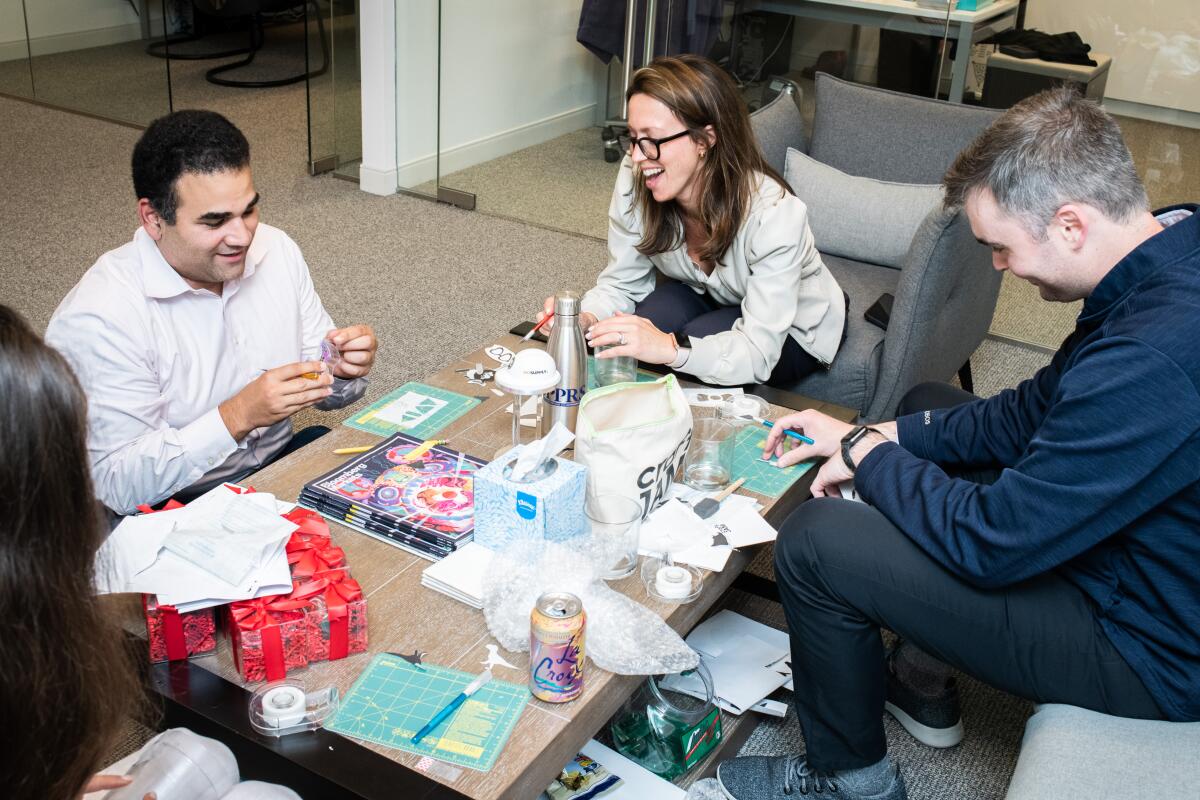
Studies have found that creative arts can improve people’s moods, lessen anxiety and manage emotions. One craft that workshop employees find especially therapeutic is marbling, which entails swirling paint colors and then brushing the blend onto leather, fabric or paper, says Denise Ambrosi, founder of These Hands Maker’s Collective studio in Culver City. Ambrosi, whose studio hosts corporate events for companies such as electric truck company Rivian Automotive, says marbling “takes you completely out of your head.”
Carolyn Mehlomakulu, a licensed art therapist in Austin, Texas, attests to the mental health benefits of fully immersing oneself in a project, in which repetitive motions can lull people into a meditative state. Art also can help people express emotions and tap into their creativity — all benefits in short supply these days.
But perhaps more important, art workshops bring employees together, fostering stronger ties. “It gets people out of their normal day-to-day interaction,” says Mehlomakulu. “Hopefully they connect in a different way through that shared experience.”
An insider’s travel guide that takes you beyond the mouse ears, selfie spots and Golden Gate Bridge.
Victoria Steger, studio director and chief operating officer at Makers Mess in downtown L.A., has seen an uptick in businesses requesting both virtual and in-person off-site events. Law firms and large tech companies sign up for tie-dyeing, watercolor and wood-burning workshops. Steger says HR directors became repeat customers after seeing how crafting workshops were effective at “fostering team-building and encouraging team members to think creatively.”
For some companies, crafting might be preferable to company mixers, which can be cliquey or held at inconvenient times.
“We have a lot of people who aren’t necessarily looking for the average happy hour after work, but they are looking to connect with their co-workers,” says Ashley Horton, officer manager at accounting software company FloQast, a Makers Mess client. FloQast employees previously painted wooden birdhouses and designed tote bags. In the coming weeks, they’ll make DIY kites.
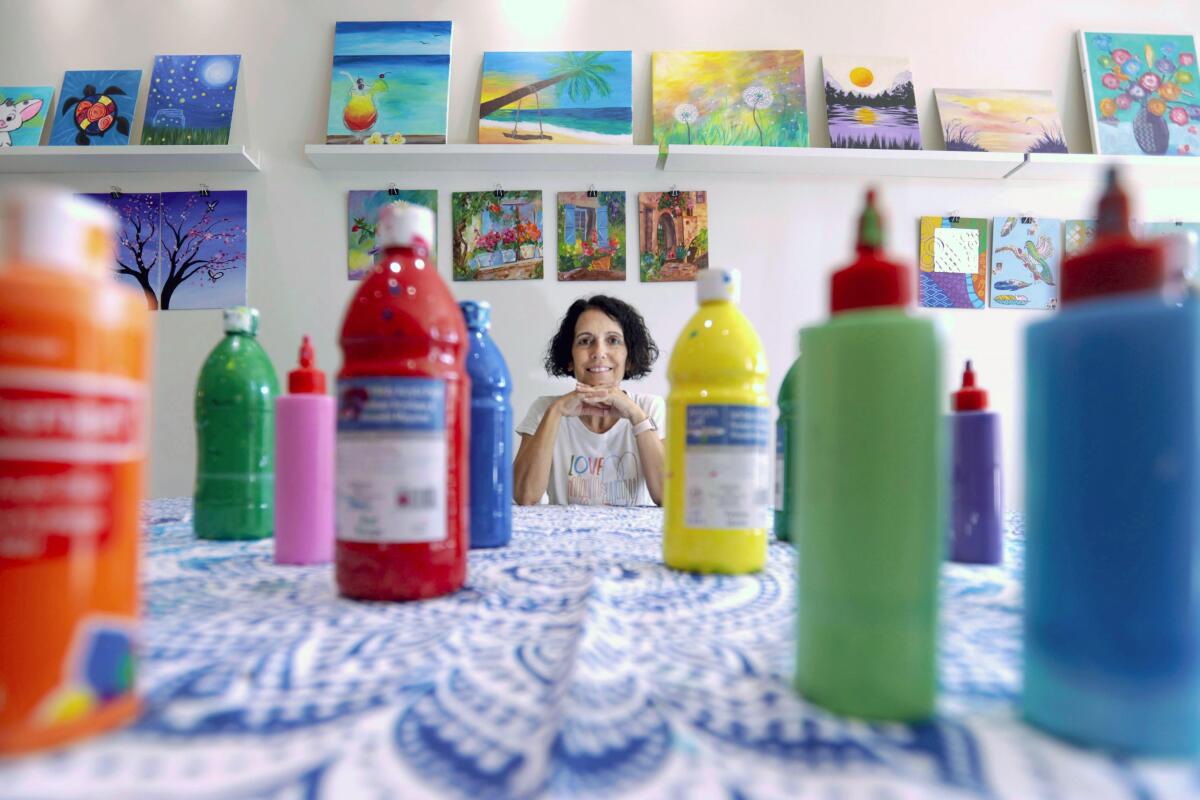
Ronit Rozen, an art instructor and owner of the Artsy Backyard in Los Angeles, works with a wide range of clients, from tech start-ups to school staff. Most sign up for painting and drawing classes, but all end up the same way: with employees and managers sitting side by side, equal in their artistic abilities (or lack thereof).
“There is no ‘I’m better than you,’” stresses Rozen.
Some women might feel that crafting is more inclusive than traditionally male-centric activities such as golf, which might put them at a competitive disadvantage. Other employees might simply feel uncomfortable wearing activewear and sweating among colleagues.
HR directors, meanwhile, might also appreciate that workshops probably entail fewer liability issues than after-work drinks.
“It’s approachable and for everyone,” explains Chloe Tsakiris, senior associate of employee engagement at Olo, a B2B company focused on digital solutions for restaurants, and a CraftJam client. “We wanted something more robust, and something that people could take away from the experience.”
Olo’s employees painted succulent pots for which CraftJam also provided the soil and plants. “It was a huge hit,” reports Tsakiris. The colorful potted plants now decorate Olo employees’ work desks.
Mental health experts point to the creative arts as a pillar of wellness, although mainstream wellness culture — and, by extension, most workplace wellness — tends to emphasize a narrower focus: nutrition, fitness, meditation and the like. Crafting experts believe this stems from experiences in childhood.
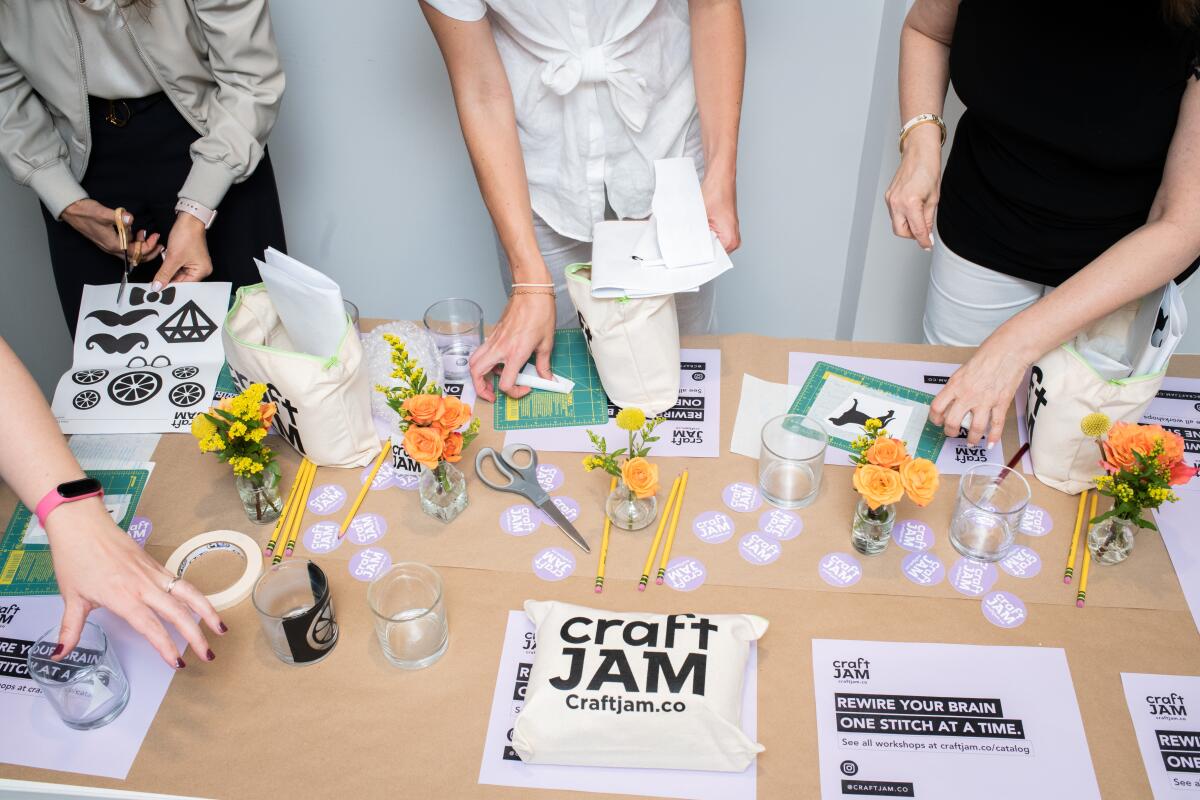
“A lot of people were taught art incorrectly and they lost confidence. They think they’re not creative,” says CraftJam’s Abousteit. Art education can sometimes be counterproductive, she notes, pointing to grades that might make some people feel insecure about their artistic abilities. “It’s almost like grading one’s personality.”
Adults might believe that some people are artistic and others simply aren’t, or that crafting requires a certain level of skill. “We often lose the sense of just making art for fun and enjoying the sensory and expressive aspects of it,” says Mehlomakulu. “You end up being focused more on the [final] product.”
Do marijuana and motherhood mix? ‘Cannamoms’ share their experiences with stigma, stress and pot parenting.
Workshops like CraftJam emphasize that art is not about competition or perfection but rather about cognitive improvement and well-being. In time, participants might become more confident and discover a self-mastery that they never knew they possessed.
The skill-building aspect greatly appeals to companies, which hope that confidence might show up in different areas of employees’ work, motivating them to explore new avenues or take innovative risks.
“Employees come to the realization that maybe they can do things that they didn’t think they were good at,” says Steger of Makers Mess.
Crafting might not appeal to all employees, but as Mehlomakulu notes, the more wellness options, the more likely somebody will find one that resonates with them. And as it turns out, nostalgia is resonating with many Americans.
“A lot of people have great memories of their childhood when they crafted,” says Abousteit. “It’s fun to return.”
Rina Raphael is a journalist and the author of the forthcoming book “The Gospel of Wellness.”
More to Read
Sign up for The Wild
We’ll help you find the best places to hike, bike and run, as well as the perfect silent spots for meditation and yoga.
You may occasionally receive promotional content from the Los Angeles Times.

